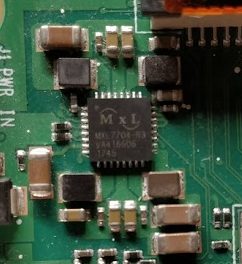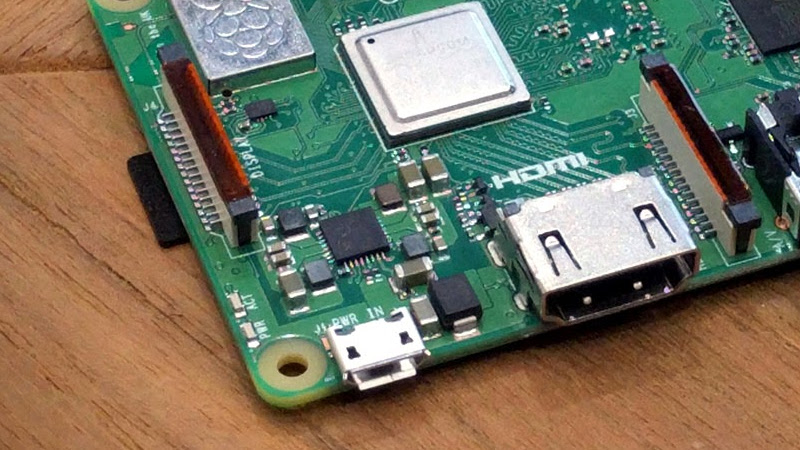You may have noticed, we’re fans of the Raspberry Pi here at Hackaday. Hardly a day goes by that we don’t feature a hack that uses a Pi somewhere in the build. As useful as the Pis are, they aren’t entirely without fault. We’ve talked about the problems with the PoE hat, and multiple articles about keeping SD cards alive. But a new failure mode has popped that is sometimes, but not always, caused by shorting the two power rails on the board.
The Pi 3 B+ has a new PMIC (Power Management Integrated Circuit) made by MaxLinear. This chip, the MxL7704, is a big part of how the Raspberry Pi foundation managed to make the upgrades to the Pi 3 without raising the price over $35.
A quick look at the Raspberry Pi forum shows that some users have been experiencing a specific problem with their new Raspberry Pi 3 B+ units, where the power LED will illuminate but the unit will not boot. The giveaway is zero voltage on the 3v3 pin. It’s a common enough problem that it’s even mentioned in the official boot problems thread.
Make sure the probe you are measuring with does not slip, and simultaneously touches any of the other GPIO pins, as that might instantly destroy your PI, especially shorting the 3V3 pin to the 5V pin will prove to be fatal.
Word From the Top: We’re Working On It
After experiencing this failure mode first-hand I decided to investigate. I reached out to the Raspberry Pi Foundation, and got a response directly from Eben Upton about the issue. He confirmed that there is a known issue: Shorting the 5V and 3V3 pins of the Raspberry Pi 3 B+ will permanently damage the PMIC. Of course shorting out power rails is a user error, but since it’s a mistake encountered by quite a few of us, they’re working on a way to fix the issue.
The interesting thing is that Eben acknowledged that a few people have experienced this failure without shorting the power pins, but it’s proven extremely difficult to troubleshoot. They are in search of someone who can reliably replicate the 3V3 failure without simply shorting the power pins. Eben even said “I would fly an engineer anywhere in the world to meet someone who can do this.” It’s not hard to see why this failure mode is so hard to track down — you can only perform it once and then the damage is done. Here’s their contact form if you happen to have info that can help.
This PMIC Fault is Not User Serviceable

The official solution to a 3V3 line failure is to contact the distributor and request a replacement Pi. The MxL7704 is officially considered not a user serviceable part. That’s obviously not enough to stop us, so I thought I’d try swapping out the bad chip for a replacement.
The MxL7704 is available through Mouser, so I ordered a couple and tried my hand at replacing the chip. Even with a hot air rework station, soldering the 0.5 mm pitch chip was too fine for me to master for this project. I discussed this with Eben and he mentioned that the chip from Mouser isn’t actually a drop-in replacement for the one on the Raspberry Pi, and suggested replacing the chip with one from a working Pi 3a+. It’s not clear to me if there are actual silicon changes, or if the differences are all in the i2c programming of the PMIC.
For all you Pi 3+ owners out there, be careful you don’t accidentally short pins on the new Raspberry Pis, as it will almost certainly brick the device. If you manage to recover your Pi by swapping out the PMIC, be sure to let us know!
















It sounds like this is what just killed my Pi 3 B+. I was doing a project with several thermal sensors- each came with a small board to simplify wiring, but the connectors were poor and wires came loose several times. I suspect one of these times caused a short from 3.3V to GND, though I don’t have any direct evidence of it.
Should I make a different choice when I purchase a replacement? It’s not that I “want” to be able to short the power rails, but I would rather choose something that is more fault tolerant, particularly for hobby projects with kids. I appreciate any advice from the group, especially within the various Pi models.
Thanks!
You can remove the 3V3 pins from the header, if you don’t use them.
I just accidentally shorted those pins on my Pi 3B (not a 3B+ by the way), and while the board is somehow still able to boot, it isn’t exactly working properly. Instead of frying PMIC, it seems to have definitely damaged the CPU to the point that, while it still boots and accepts keyboard input, it quickly begins to overheat and the GPIO pins no longer work.
Did anyone figure out a way around this. I have a 3B+ that has 2.2v on the 3.3v line and it seems like it should be against the law to make this item so that it is unrepairable because it creates unnecessary e-waste.
Yeah. I’ve had this happen on other equipment. When you short 5V to ground briefly, and then un-short the line 5V a large voltage spike can be created on the 5V line, and that goes everywhere, and that can do very bad things.
After years of use a 3B+ (Pi-Hole) just died by my finger :/ I did this 3.3v-5v bridge with a finger, while I was re adjusting the Pi inside its new home-made case. By pushing a bit on the pins of a FanHAT from waveshare. Without a poweroff. This is a very nice hat but the pins are maybe a bit too flexable? I did not notice the pins were in touch first, but the immediate shutdwn of everything was clearly disturbing…. and I made 2 reset before seeing the pins kissing each other… have several Pis and this is the first and the last to die this way. Mistake. I love this board) Take care of yours, may these words help you think about these felxable pins some HAT have!
Just did this for the second time. I got caught on a wire dropped it while powered up and i guess pins 1 and 2 touched something metal. I even had a piece of foam on the pins to prevent this from happening again but they poked through just enough.
Seems extreemly stupid to put the two worst pins to short on the end that is most exposed.